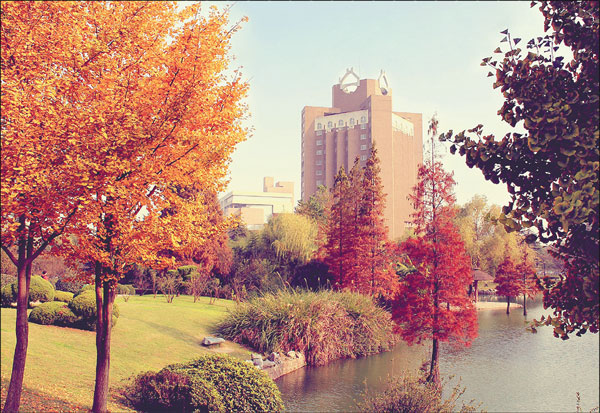|
 |
|
Trees and a gentle lake add a peaceful ambience to the area outside the library building of the University of Science and Technology of China. Provided to China Daily
|
A decade ago, most graduates of the University of Science and Technology of China tended to study abroad and settle in the United States.
But today an increasing number of outstanding professors and experts are opting to return from overseas to work and live in China. And USTC is a top choice.
One of the premier universities in China, USTC was established in Beijing in 1958 by the Chinese Academy of Sciences and was relocated to Hefei, Anhui province, in 1970.
Ranked 49th in the 2011 Times Higher Education list of the world's top universities, the school has a tradition of hiring faculty and administration who have returned from overseas.
It is currently recruiting professionals from China and abroad as well as organizing regular recruitment and exchange trips to other countries.
With the help of some national plans to attract top professionals from around the world, USTC has drawn some 300 experts from overseas since 2009. Now, more than 24 percent of the faculty members are returnees, a level much higher than the national average.
"Talented people are a treasure to us, and we welcome them no matter where they are from," said Hou Jianguo, president of the university, on a trip to the US in 2010, adding that USTC aims to be a world-class research university by welcoming more communication and cooperation with US scholars.
"China today is offering golden opportunities for research and development in some science and technology fields, which ambitious overseas experts would not want to miss," said the president, who returned to China from working abroad in 1995.
Although Hefei is not competitive against Beijing or Shanghai economically, the city has undergone tremendous changes over the past few years. Brand new international airports and high-speed railways as well as the construction of high-rise buildings will attract more global talent, Hou said.
Hefei is ranked the world's fastest-growing metropolitan economy in terms of real per capita GDP, and it has grown at an average annual pace of some 15 percent in recent years, according to a report by The Economist in 2012.
USTC has a better track record than many institutions when it comes to dealing with top faculty, said Qin Hong, formerly the director of research for the Plasma Physics program at Princeton University.
"USTC's offer may not have been the best, but all their promises have been honored," Qin said.
All the arrangements for research funds, labs, offices, housing and other considerations are written into contracts, which guarantees in writing that professionals will have everything they need, said Dou Xiankang, vice-president of USTC.
Apartments are offered by USTC almost free of charge, which is particularly attractive to young scientists because it enables them to better focus on their research, said Bi Guoqiang, who came back from the University of Pittsburgh.
Bi, who has a boy and a girl, also noted that USTC has its own attached kindergarten, elementary and middle schools, which are among the best in Hefei.
The city is one of the four known for having an edge in science and education nationwide, and it is second only to Beijing in terms of the total number of national laboratories, according to Nature Publishing Index 2012.
Liang Haiyi, who came from the School of Engineering and Applied Sciences at Harvard University in 2010, said the atmosphere of academic freedom at USTC is equally attractive.
"Here in USTC, I work on whatever interests me, whether it is practical or impractical," he said.
One of Liang's research focuses is studying lily's blossom. Using mathematical theory, observation and experimentation, Liang and his partner from Harvard University have unveiled the mystery behind the process.
Studying a flower blooming my seem trivial, but Liang explained that the research results could be generalized so that they can be applied to materials science involving thin films and elastic sheets. And it could also affect the development of devices, such as sensors and actuators that mimic the mechanism of blooming.
Yao Huajian, who graduated from Massachusetts Institute of Technology with a doctoral degree and now works with the School of Earth and Space Science of USTC, said, "USTC's open culture is similar to that of many US universities, which has eased the transition and created a sense of belonging."
Chen Yuao, who returned from Germany, now works in the Hefei National Laboratory of Physical Sciences at the Microscale, a facility under USTC.
The 32-year-old won the European Physical Society's Fresnel Prize in May at the European Conference on Lasers and Electro-Optics in Munich.
The prize is named after Augustin-Jean Fresnel, a leading physicist in the 19th century. It is regarded as the highest global honor for scientists under the age of 35 in the field of quantum electronics and optics.
"USTC is like a harbor, where boats from various places are welcomed to anchor," Hou said.
Ji Beibei contributed to this story.
|